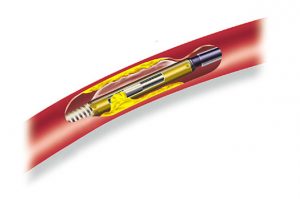
An atherectomy device is a medical device used to remove plaque from inside the arteries. The device is designed to treat atherosclerosis, a condition in which the arteries become narrowed due to the buildup of plaque. Atherectomy is a minimally invasive procedure that is performed using a catheter, which is inserted into the artery through a small incision in the skin.
The atherectomy device has a rotating blade or a laser at its tip, which is used to remove the plaque from the artery. The device works by shaving or vaporizing the plaque, leaving behind a smooth surface inside the artery. This can help to improve blood flow and reduce the risk of future blockages.
Atherectomy devices are often used in conjunction with other treatments for atherosclerosis, such as angioplasty or stenting. They can be used in various arteries of the body, including the coronary arteries in the heart, the carotid arteries in the neck, and the femoral arteries in the legs.
The use of atherectomy devices has been shown to be safe and effective in treating atherosclerosis, and the technology is constantly improving to provide even better outcomes for patients.
There are several types of atherectomy procedures, which use different techniques to remove plaque from inside the arteries. Here are the most common types of atherectomy:
- Directional atherectomy: This type of atherectomy uses a catheter with a blade on the end that rotates and cuts the plaque, which is then collected and removed from the artery. This technique is often used for treating blockages in the leg arteries.
- Rotational atherectomy: This type of atherectomy uses a catheter with a diamond-coated burr on the end that spins rapidly, grinding the plaque into small particles that are then removed by the bloodstream. This technique is often used for treating blockages in the coronary arteries.
- Orbital atherectomy: This type of atherectomy uses a catheter with a diamond-coated crown on the end that orbits around the plaque, sanding it away in a circular motion. This technique is often used for treating heavily calcified blockages in the coronary arteries.
- Laser atherectomy: This type of atherectomy uses a catheter with a laser on the end that vaporizes the plaque, leaving behind a smooth surface inside the artery. This technique is often used for treating blockages in the carotid arteries.
The choice of atherectomy technique depends on the location and severity of the blockage, as well as other factors specific to the patient. Each type of atherectomy has its own advantages and disadvantages, and your doctor can help you decide which technique is best for your individual situation.
Atherectomy is a minimally invasive procedure that is used to remove plaque from inside the arteries. Plaque is a buildup of cholesterol, fat, calcium, and other substances that can narrow or block the arteries, leading to reduced blood flow and an increased risk of heart attack or stroke.
During an atherectomy procedure, a thin, flexible catheter is inserted into an artery through a small incision in the skin. The catheter is guided to the site of the blockage using X-ray or ultrasound imaging. Once the catheter is in place, the atherectomy device is used to remove or modify the plaque.
There are different types of atherectomy devices, each with its own technique for removing plaque. The most common types of atherectomy include directional, rotational, orbital, and laser atherectomy.
Atherectomy is usually performed on an outpatient basis and does not require general anesthesia. The procedure can take anywhere from 30 minutes to several hours, depending on the location and severity of the blockage.
After the procedure, patients may need to lie still for a period of time to prevent bleeding or other complications. Most patients are able to resume normal activities within a few days, although strenuous exercise and heavy lifting may need to be avoided for a period of time.
Atherectomy is generally considered safe and effective, although like any medical procedure, there are potential risks and complications, including bleeding, infection, and damage to the artery or surrounding tissues.
The first atherectomy device was the Simpson Atherocath, which was invented by Dr. Richard Simpson in the 1980s. The Atherocath was a directional atherectomy device that used a tiny rotating blade to shave off plaque from the inside of the artery. It was one of the first minimally invasive treatments for peripheral artery disease and was approved by the US Food and Drug Administration (FDA) in 1987. The Simpson Atherocath was later followed by other types of atherectomy devices, such as rotational, orbital, and laser atherectomy devices, which use different methods to remove plaque from the arteries.
There are several types of atherectomy devices, each with its own technique for removing plaque from the arteries. The most common types of atherectomy devices include:
- Directional atherectomy devices: These devices use a rotating blade or cutting disk to shave off the plaque from the inside of the artery. The blade is designed to cut in a specific direction, allowing the device to remove the plaque while minimizing damage to the artery wall.
- Rotational atherectomy devices: These devices use a high-speed rotating burr to break up and remove the plaque. The burr is guided to the site of the blockage and is then rotated at high speeds to remove the plaque.
- Orbital atherectomy devices: These devices use a diamond-coated crown that rotates at a high speed to sand down and remove the plaque. The crown rotates in a circular motion, allowing it to remove the plaque from all sides of the artery.
- Laser atherectomy devices: These devices use a laser to vaporize the plaque, turning it into a gas that is then removed from the artery. The laser is guided to the site of the blockage and is then used to remove the plaque.
Each type of atherectomy device has its own advantages and disadvantages, and the choice of device depends on the location and severity of the blockage, as well as the preferences of the treating physician.



